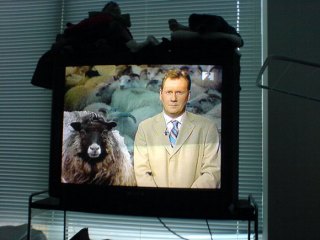By Snorri Páll Jónsson Úlfhildarson, originally published in The Reykjavík Grapevine.
Those who are yet to give up on Icelandic media cannot have avoided noticing one Kristján Már Unnarsson, a news director and journalist at TV station Stöð 2. Kristján, who in 2007 received the Icelandic Press Awards for his coverage of “everyday countryside life”, is a peculiar fan of manful and mighty constructions and loves to tell good news to and about all the “good heavy industry guys” that Iceland has to offer.
To be more precise, Kristján has, for at least a decade (and I say “at least” just because my memory and research doesn’t take me further back), gone on a rampage each and every time he gets the chance to tell his audience about the newest of news in Iceland’s heavy industry and energy affairs. He talks about gold-mills when referring to dams built to power aluminium production; and when preparing an evening news item on, say, plans regarding energy and aluminium production, he usually doesn’t see a reason for talking to more than one person – a person who, almost without exception, is in favour of whatever project is being discussed.
After witnessing Kristján’s latest contribution to the ongoing development of heavy industry and large-scale energy production, i.e. his coverage of Alcoa’s recently announced decision not to continue with its plan of building a new aluminium smelter in Húsavík, wherein he managed to blame just anything but Alcoa itself for the company’s decisions, I couldn’t resist asking (and, really, not for the first time): What can really explain this way too obvious one-sidedness, manifest not only in this one journalist’s work but seemingly the majority of news coverage concerning heavy industry?
“Lack of professionalism,” someone might say. Professionalism would thus imply allowing more than one single voice to be heard, letting one argument meet another, allowing conflicts to take place and thereby giving the audience a chance to critically make up its mind. This lack of professionalism actually applies to such a huge quantity of all news material produced. Indeed, the constant recycling of content – of interviews, press-releases, photos etc. – and the manufacture of single-perspective news content often seems to be the mainstream media’s predominant modus operandi.
“Co-dependency,” could be another suggestion. And a good one, as it often seems that the bulk of journalists are seriously co-dependant with the ruling political and economical order. Take, for instance, the mantra of the never-questioned importance of non-stop economic growth, or the commonly heard phrase that during a protest “the police needed to use teargas” – as the decision to spray isn’t fuelled by a precise political will, but rather of a simple need.
These two are good answers, but definitely not good enough when standing on their own. To get the full picture, lets look into the relationship between mainstream journalism on the one hand, and public relations on the other. How, for instance, are the tops of the aluminium and energy companies’ PR departments staffed?
At Reykjavík Energy we have Eiríkur Hjálmarsson, former journalist and program maker at state TV station RÚV, whereas at Landsvirkjun we find one Ragna Sara Jónsdóttir, former journalist at RÚV and newspaper Morgunblaðið. Alcoa prides itself of Erna Indriðadóttir, long-time journalist at RÚV, while Rio Tinto Alcan sports Ólafur Teitur Guðnason, former journalist at RÚV, DV and business paper Viðskiptablaðið (it is worth noting that Ólafur is also known for his aonce-annual books analysing and criticising the mdia, not from the usual Chomsky-alike left-wing but rather a right-wing perspective). At last but not least, the only employee of Samál (or The Icelandic Association of Aluminium Producers), is Þorsteinn Víglundsson who, along with a few jobs in the financial sector, used to write news for Morgunblaðið.
Quite an impressive list, isn’t? And where does it bring us? Possibly to the assumption that the first-mentioned Kristján Már Unnarsson must be doing his entrance examination, or even an on-the-job-training. But that would be a bit too simplistic because practically, Kristján Már might well be preparing for a better paid PR job, whereas theoretically it really doesn’t mater if that is the case or not.
What matters is the ever impenetrable handshake between those two industries: Public Relations and The Media. What, in fact, is one medium’s coverage of a company but a conversation between the two parties? A pre-designed and post-edited conversation, for sure, but a conversation nevertheless. And the conversation element is crucial as a journalist’s co-dependency and lack of professionalism (deliberate or not) are of no use if the Holy Trinity’s most important link is missing. And vice versa: Without beneficial journalists, a PR stunt is likely to end up dead in the water.
The stunt’s key moment, as Spice Girls realised and told us, is “when two become one.”

Really nice article!
The link between Media and PR is also mentioned in another piece in this same Grapevine edition. In an article on page 10 says Íris Erlingsdóttir:
“According to the Investigative Report [about Iceland’s economic collapse], four out of five Icelandic news stories about the banks and financial matters originated from the banks’ PR departments.”